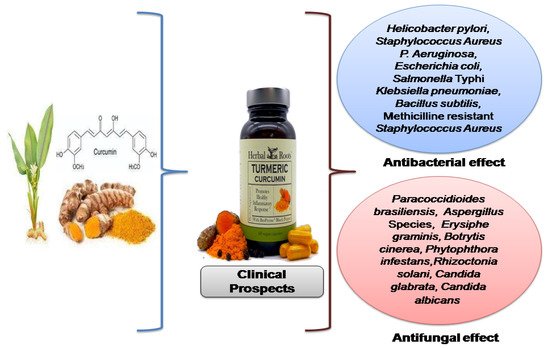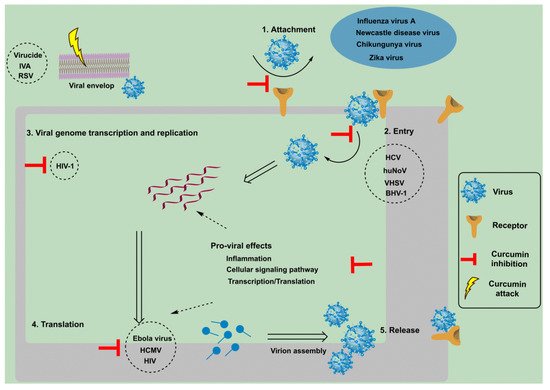Curcumin is a bioactive compound that is extracted from Curcuma longa and that is known for its antimicrobial properties. Curcuminoids are the main constituents of curcumin that exhibit antioxidant properties. It has a broad spectrum of antibacterial actions against a wide range of bacteria, even those resistant to antibiotics. Curcumin has been shown to be effective against the microorganisms that are responsible for surgical infections and implant-related bone infections, primarily Staphylococcus aureus and Escherichia coli. The efficacy of curcumin against Helicobacter pylori and Mycobacterium tuberculosis, alone or in combination with other classic antibiotics, is one of its most promising antibacterial effects. Curcumin is known to have antifungal action against numerous fungi that are responsible for a variety of infections, including dermatophytosis. Candidemia and candidiasis caused by Candida species have also been reported to be treated using curcumin. Life-threatening diseases and infections caused by viruses can be counteracted by curcumin, recognizing its antiviral potential.
- curcumin
- antimicrobial potential
1. Introduction
2. Antibacterial Effect
Curcumin inhibits the growth of both Gram-negative and Gram-positive bacteria. [11][12]. Different antimicrobial strains such as Escherichia coli, Pseudomonas aeruginosa, Staphylococcus epidermidis, and Staphylococcus aureus were assayed. They reported that curcumin showed potential antibacterial activity against all of the tested species, indium diacetyl-curcumin revealed an antibacterial effect against Staphylococcus epidermidis and Staphylococcus aureus, diacetyl-curcumin had no antibacterial effect on any species, whereas it was reported that indium curcumin demonstrated significant antibacterial potential against all of the tested strains. They also determined the MIC of all of the compounds against each of the antibacterial species and found that the MIC of curcumin against Staphylococcus aureus and Staphylococcus epidermidis was 187.5 µg/mL and 46.9 µg/mL, respectively. The MIC for indium curcumin was determined to be slightly less than that of the other two species above, which were 93.8 µg/mL and 23.4 µg/mL, respectively. Thus, their analysis established that indium curcumin has a higher antibacterial effect compared to curcumin [13].
A lot of in vitro investigations have shown that curcumin possesses antimicrobial activity towards microbes such as and Gram-positive and Gram-negative bacteria [14][15][16][17]. Curcumin has a wide range of mechanistic pathways that are responsible for these antimicrobial actions. These pathways may include DNA replication inhibition, the modifications in plasmid gene expression, cell membrane deterioration, and motility reductions.
Curcumin has been reported to be a promising breaker of antimicrobial resistance, as curcumin has the potential to restore the effectiveness of failed antimicrobials by lowering their MICs. Researchers investigated the resistance of a multi-drug resistant strain of Mycobacterium abscessus (isolated from a 66-year-old tuberculosis patient) against curcumin. In 2018, Marini treated resistant strains of M. abscessus with a combination therapy with different concentration of curcumin with clarithromycin, linezolid, ciprofloxacin, and amikacin. Curcumin slightly decreased the pathogenicity (degree or state of being pathogenic) at 1/8 × MIC, while at 4 × MIC, it totally blocked biofilms from 4 to 8 days. Additive curcumin and amikacin therapy caused a significant decline in the viable cell count as well as a decrease in the microbial colonies. While curcumin was the main agent, the most notable feature observed was the biofilm destruction on the 4th and 8th days. These results backed up past evidence that curcumin can help break resistance to antibiotics. Curcumin, alone or in combination with antibiotics, may help to establish a new approach for combating the pathogenicity and drug resistance of M. abscessus [18]. Methicillin-resistant Staphylococcus aureus-related hospital infections are a global public health issue. In combination with other antibiotics, curcumin is effective against such resistance. Due to its low systemic bioavailability, curcumin was formulated in the form of graphene oxide nanoparticles and was targeted for antibiotic activity. The fabricated curcumin nanoparticles showed low toxicity and effective anti-bacterial activity against antibiotic-resistant infection at concentrations of less than 2 µg/mL [19].
3. Antifungal Effect
Curcumin was quite effective against isolated strains of Paracoccidioides brasiliensis, but it had no effect on Aspergillus strains. The adherence of Candida species was more efficiently inhibited by curcumin compared to fluconazole, especially in the buccal mucosal strains that were isolated from patient suffering from AIDS, proving that curcumin is indeed a potential natural compound that deserves more research into its pharmacological activity in immunosuppressed individuals. Thus, the researchers concluded that curcumin is an effective antifungal agent for the management of P. brasiliensis infection compared to fluconazole [20].

4. Antiviral Effect

5. Synergistic Effects
6. Therapeutic Challenges and Solutions
This entry is adapted from the peer-reviewed paper 10.3390/antibiotics11030322
References
- Bar-Sela, G.; Epelbaum, R.; Schaffer, M. Curcumin as an anti-cancer agent: Review of the gap between basic and clinical applications. Curr. Med. Chem. 2010, 17, 190–197.
- Sharma, R.; Gescher, A.; Steward, W. Curcumin: The story so far. Eur. J. Cancer 2005, 41, 1955–1968.
- Aggarwal, B.B.; Harikumar, K.B. Potential therapeutic effects of curcumin, the anti-inflammatory agent, against neurodegenerative, cardiovascular, pulmonary, metabolic, autoimmune and neoplastic diseases. Int. J. Biochem. Cell Biol. 2009, 41, 40–59.
- Trujillo, J.; Chirino, Y.I.; Molina-Jijón, E.; Andérica-Romero, A.C.; Tapia, E.; Pedraza-Chaverrí, J. Renoprotective effect of the antioxidant curcumin: Recent findings. Redox Biol. 2013, 1, 448–456.
- Gupta, S.C.; Patchva, S.; Aggarwal, B.B. Therapeutic roles of curcumin: Lessons learned from clinical trials. AAPS J. 2013, 15, 195–218.
- Hatcher, H.; Planalp, R.; Cho, J.; Torti, F.; Torti, S. Curcumin: From ancient medicine to current clinical trials. Cell. Mol. Life Sci. 2008, 65, 1631–1652.
- Shlar, I.; Poverenov, E.; Vinokur, Y.; Horev, B.; Droby, S.; Rodov, V. High-throughput screening of nanoparticle-stabilizing ligands: Application to preparing antimicrobial curcumin nanoparticles by antisolvent precipitation. Nanomicro Lett. 2015, 7, 68–79.
- Wang, S.; Tan, M.; Zhong, Z.; Chen, M.; Wang, Y. Nanotechnologies for curcumin: An ancient puzzler meets modern solutions. J. Nanomater. 2011, 2011, 1–8.
- Kaur, S.; Modi, N.H.; Panda, D.; Roy, N. Probing the binding site of curcumin in Escherichia coli and Bacillus subtilis FtsZ–a structural insight to unveil antibacterial activity of curcumin. Eur. J. Med. Chem. 2010, 45, 4209–4214.
- Rai, D.; Singh, J.K.; Roy, N.; Panda, D. Curcumin inhibits FtsZ assembly: An attractive mechanism for its antibacterial activity. Biochem. J. 2008, 410, 147–155.
- Gupta, S.C.; Patchva, S.; Koh, W.; Aggarwal, B.B. Discovery of curcumin, a component of golden spice, and its miraculous biological activities. Clin. Exp. Pharmacol. Physiol. 2012, 39, 283–299.
- Tyagi, P.; Singh, M.; Kumari, H.; Kumari, A.; Mukhopadhyay, K. Bactericidal activity of curcumin I is associated with damaging of bacterial membrane. PLoS ONE 2015, 10, e0121313.
- Tajbakhsh, S.; Mohammadi, K.; Deilami, I.; Zandi, K.; Fouladvand, M.; Ramedani, E.; Asayesh, G. Antibacterial activity of indium curcumin and indium diacetylcurcumin. Afr. J. Biotechnol. 2008, 7, 3832–3835.
- Mun, S.-H.; Joung, D.-K.; Kim, Y.-S.; Kang, O.-H.; Kim, S.-B.; Seo, Y.-S.; Kim, Y.-C.; Lee, D.-S.; Shin, D.-W.; Kweon, K.-T. Synergistic antibacterial effect of curcumin against methicillin-resistant Staphylococcus aureus. Phytomedicine 2013, 20, 714–718.
- Yun, D.G.; Lee, D.G. Antibacterial activity of curcumin via apoptosis-like response in Escherichia coli. App. Microbiol. Biotechnol. 2016, 100, 5505–5514.
- Betts, J.W.; Wareham, D.W. In vitro activity of curcumin in combination with epigallocatechin gallate (EGCG) versus multidrug-resistant Acinetobacter baumannii. BMC Microbiol. 2014, 14, 172.
- Lüer, S.; Troller, R.; Aebi, C. Antibacterial and antiinflammatory kinetics of curcumin as a potential antimucositis agent in cancer patients. Nutr. Cancer 2012, 64, 975–981.
- Marini, E.; Di Giulio, M.; Magi, G.; Di Lodovico, S.; Cimarelli, M.E.; Brenciani, A.; Nostro, A.; Cellini, L.; Facinelli, B. Curcumin, an antibiotic resistance breaker against a multiresistant clinical isolate of Mycobacterium abscessus. Phytother. Res. 2018, 32, 488–495.
- Bugli, F.; Cacaci, M.; Palmieri, V.; Di Santo, R.; Torelli, R.; Ciasca, G.; Di Vito, M.; Vitali, A.; Conti, C.; Sanguinetti, M. Curcumin-loaded graphene oxide flakes as an effective antibacterial system against methicillin-resistant Staphylococcus aureus. Interface Focus 2018, 8, 20170059.
- Martins, C.; Da Silva, D.; Neres, A.; Magalhaes, T.; Watanabe, G.; Modolo, L.; Sabino, A.; De Fátima, A.; De Resende, M. Curcumin as a promising antifungal of clinical interest. J. Antimicrob. Chemother. 2009, 63, 337–339.
- Mathew, D.; Hsu, W.-L. Antiviral potential of curcumin. J. Funct. Foods 2018, 40, 692–699.
- Desai, S.J.; Prickril, B.; Rasooly, A. Mechanisms of phytonutrient modulation of cyclooxygenase-2 (COX-2) and inflammation related to cancer. Nutr. Cancer 2018, 70, 350–375.
- Mounce, B.C.; Cesaro, T.; Carrau, L.; Vallet, T.; Vignuzzi, M. Curcumin inhibits Zika and chikungunya virus infection by inhibiting cell binding. Antivir. Res. 2017, 142, 148–157.
- Zhu, L.; Ding, X.; Zhang, D.; Ch, Y.; Wang, J.; Ndegwa, E.; Zhu, G. Curcumin inhibits bovine herpesvirus type 1 entry into MDBK cells. Acta Virol. 2015, 59, 221–227.
- Shin, B.; Park, W. Zoonotic diseases and phytochemical medicines for microbial infections in veterinary science: Current state and future perspective. Front. Vet. Sci. 2018, 5, 166.
- Güran, M.; Şanlıtürk, G.; Kerküklü, N.R.; Altundağ, E.M.; Yalçın, A.S. Combined effects of quercetin and curcumin on anti-inflammatory and antimicrobial parameters in vitro. Eur. J. Pharmacol. 2019, 859, 172486.
- Li, Y.; Xu, Y.; Liao, Q.; Xie, M.; Tao, H.; Wang, H.L. Synergistic effect of hypocrellin B and curcumin on photodynamic inactivation of Staphylococcus aureus. Microb. Biotechnol. 2021, 14, 692–707.
- Ratrey, P.; Dalvi, S.V.; Mishra, A. Enhancing aqueous solubility and antibacterial activity of curcumin by complexing with cell-penetrating octaarginine. ACS Omega 2020, 5, 19004–19013.
- Sharma, G.; Dang, S.; Kalia, M.; Gabrani, R. Synergistic antibacterial and anti-biofilm activity of nisin like bacteriocin with curcumin and cinnamaldehyde against ESBL and MBL producing clinical strains. Biofouling 2020, 36, 710–724.
- Altundağ, E.M.; Toprak, K.; Şanlıtürk, G.; Güran, M.; Özbilenler, C.; Kerküklü, N.R.; Yılmaz, A.M.; Yalçın, A.S. Synergistic combination of histone deacetylase inhibitor suberoylanilide hydroxamic acid and natural flavonoid curcumin exhibits anticancer and antibacterial activity. Anticancer Agents Med. Chem. 2020, 21, 1301–1308.
- Bhatia, E.; Sharma, S.; Jadhav, K.; Banerjee, R. Combinatorial liposomes of berberine and curcumin inhibit biofilm formation and intracellular methicillin resistant Staphylococcus aureus infections and associated inflammation. J. Mater. Chem. B. 2021, 9, 864–875.
- Ibrahima, S.; Solimana, O.; Sultana, M. Synergistic antimicrobial effect of xylitol with curcumin: Water vapor barrier, mechanical and thermal properties of PSS/PVA packaging films. Int. J. Appl. Eng. Res. 2017, 12, 10360–10366.
- Dai, C.; Wang, Y.; Sharma, G.; Shen, J.; Velkov, T.; Xiao, X. Polymyxins–curcumin combination antimicrobial therapy: Safety implications and efficacy for infection treatment. Antioxidants 2020, 9, 506.
- Karthikeyan, A.; Senthil, N.; Min, T. Nanocurcumin: A promising candidate for therapeutic applications. Front. Pharmacol. 2020, 11, 487.
